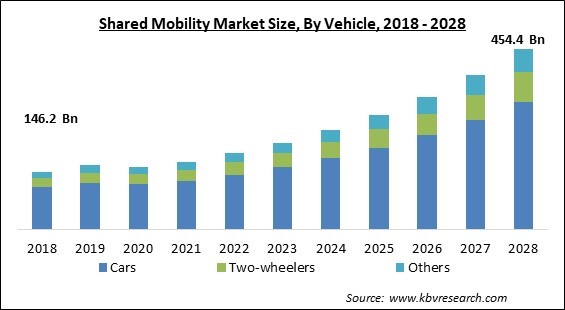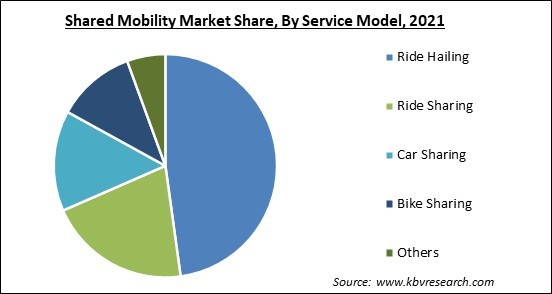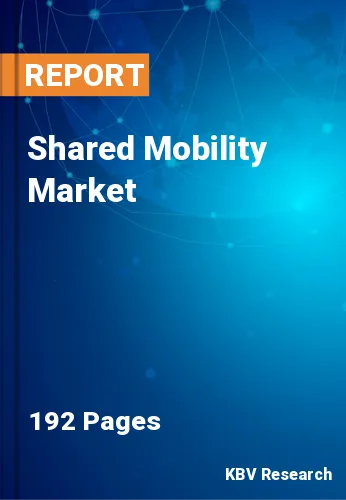The Global Shared Mobility Market size is expected to reach $454.4 billion by 2028, rising at a market growth of 15.4% CAGR during the forecast period.
New technologies & business models have helped to improve transportation systems & services in the direction of a more sustainable mobility approach. Shared mobility has gained popularity as a possible answer to the rising number of vehicles. Several communities throughout the world have adopted shared mobility services, demonstrating that they may provide various operational and environmental benefits. Although, in rural and suburban areas with less population density and diffused travel demand, their deployment does not receive the same level of attention.

Peer-to-peer vehicle sharing, shared ride-sharing, common electric scooters, and other new modes & services have arisen. The possibilities for integration, customized travel on demand, automated operations, and environmental friendliness have all contributed to the growth of the shared mobility market. One of the primary aspects propelling the demand for shared mobility is the increasing adoption of linked cars and smartphones. The expense of road vehicles and fuel, combined with a decrease in parking, is expected to promote market growth in the near future, particularly in industrialized nations around the world.
Furthermore, compared to other forms of transportation, shared mobility solutions are cheaper and avoid limited parking issues. Several governments throughout the world are developing programmers to encourage the adoption of these solutions in order to minimize traffic congestion. This has a substantial impact on commuters' lifestyles and the marketplace as a whole, like enhanced accessibility, better transportation, less driving, and lower personal car ownership. Shared mobility plans usually provide social, environmental, and transportation system advantages. Commuters use public transportation, which includes shared public transportation, micro mobility, commute-based modes, automobile-based mode, and ridesharing.
Owing to modifications in people's mobility patterns around the world, COVID-19 has had a detrimental influence on increasing the market for shared mobility. During the pandemic, people's mobility reduced dramatically, reducing the number of visits to workplaces that was among the market's major factors and drivers. The pandemic has also caused a transformation in commute priorities. Prior to COVID, commuters' primary concerns were the cost of service, comfort, and other factors such as travel time and mode of transportation. Commuters now seek out forms of transportation that are safe, sanitary, and have a low risk of illness. As a result, prioritizing health is likely to reduce the usage of sharing and public transportation. Additionally, during the global pandemic, car-sharing services had either been decreased or halted because of a lack of demand in the market.
Every country's government is concerned about population growth, which has negative environmental consequences. Governments encourage citizens to limit their use of automobiles as much as possible. Additionally, sharing rides amongst friends and families are among the government's important concepts for encouraging individuals to choose shared rides above personal rides, which is motivating key companies to launch various news products. Along with that, there are many governments across the world, which are taking steps to establish a network of shared mobility to motivate people for the usage of shared mobility.
Population increase in key cities around the country has resulted in a rise in daily commuters, causing substantial traffic congestion, particularly during rush hour. In order to fight this problem, some companies are attempting to develop alternate transportation solutions. This environment is a primary factor for the market for shared mobility. Various programs make a significant contribution to alleviating traffic congestion, which would open lucrative opportunities for the market players. Since, the level pollutant in the atmosphere is constantly increasing, organizations across the world are taking initiatives to aware people about the effects of pollution on the environment.

Many cities lack the requisite infrastructure for the vehicles that fall under micro-mobility concepts, and hence lack the charging infrastructure to charge these vehicles, which is one of the most significant impediments to the demand for shared mobility. Bike lanes are the only realistic solution since riding an e-scooter in fast lanes (truck, car, and bus dominated) or on sidewalks (pedestrian dominated) poses a significant risk to all traffic participants. Because governments are not concentrated on this new and rising concept, dedicated lanes of micro-mobility solutions are lacking in many countries. Furthermore, developing charging infrastructure for micro-mobility solutions necessitates a significant investment as well as the implementation of relevant legislation.
Based on Service Model, the market is segmented into Ride Hailing, Ride Sharing, Car Sharing, Bike Sharing and Others. Bike sharing segment acquired a significant revenue share in the shared mobility market in 2021. Two-wheeler services are likely to grow in popularity in the next years, as they are regarded the quickest and most efficient mode of transportation on congested city streets. The United States, Spain, China, and Italy are among the nations with the largest use of these services.
Based on Vehicle, the market is segmented into Cars, Two-wheelers, and Others. The cars segment garnered the highest revenue share in the shared mobility market in 2021. Two-wheeler services are projected to grow in popularity in the future years, as motorcycles are seen as a cost-effective and substantially speedier means of transportation on congested city roads. When a consumer becomes familiarized to electric vehicles, they would then notice that the cost per kilometre for an EV is 4-5 times lower for two-wheelers and three 3-10 times lower for four-wheelers in comparison to fuel-driven vehicles, provided that the electricity rate is 110 cents per unit and the cost of gasoline is 1100 cents.
| Report Attribute | Details |
|---|---|
| Market size value in 2021 | USD 169.9 Billion |
| Market size forecast in 2028 | USD 454.4 Billion |
| Base Year | 2021 |
| Historical Period | 2018 to 2020 |
| Forecast Period | 2022 to 2028 |
| Revenue Growth Rate | CAGR of 15.4% from 2022 to 2028 |
| Number of Pages | 192 |
| Number of Tables | 280 |
| Report coverage | Market Trends, Revenue Estimation and Forecast, Segmentation Analysis, Regional and Country Breakdown, Companies Strategic Developments, Company Profiling |
| Segments covered | Service Model, Vehicle, Region |
| Country scope | US, Canada, Mexico, Germany, UK, France, Russia, Spain, Italy, China, Japan, India, South Korea, Singapore, Malaysia, Brazil, Argentina, UAE, Saudi Arabia, South Africa, Nigeria |
| Growth Drivers |
|
| Restraints |
|
Based on Regions, the market is segmented into North America, Europe, Asia Pacific, and Latin America, Middle East & Africa. Asia Pacific emerged as the leading region in the shared mobility market with the maximum revenue share in 2021. This is mostly owing to the region's widespread acceptance of technology and quick proliferation of smart homes. In nations like China and India, the expense of traffic and car ownership is constantly rising.
Free Valuable Insights: Global Shared Mobility Market size to reach USD 454.4 Billion by 2028
The market research report covers the analysis of key stake holders of the market. Key companies profiled in the report include Lyft, Inc., Grab Holdings Inc. Avis Budget Group, Inc., DiDi Global Inc., Deutsche Bahn Connect GmbH (Deutsche Bahn AG), Uber Technologies, Inc., GT Gettaxi (UK) Limited, Ola Cabs (ANI Technologies Pvt. Ltd.), Share Now GmbH, and Global Car Sharing and Rental Co., Ltd.
By Service Model
By Vehicle
By Geography
The global shared mobility market size is expected to reach $454.4 billion by 2028.
Rising government support and investments are driving the market in coming years, however, Lack of charging infrastructure for micro-mobility solutions limited the growth of the market.
Lyft, Inc., Grab Holdings Inc. Avis Budget Group, Inc., DiDi Global Inc., Deutsche Bahn Connect GmbH (Deutsche Bahn AG), Uber Technologies, Inc., GT Gettaxi (UK) Limited, Ola Cabs (ANI Technologies Pvt. Ltd.), Share Now GmbH, and Global Car Sharing and Rental Co., Ltd.
The expected CAGR of the shared mobility market is 15.4% from 2022 to 2028.
The Ride Hailing segment acquired maximum revenue share in the Global Shared Mobility Market by Service Model in 2021, thereby, achieving a market value of $209.6 billion by 2028.
The Asia Pacific market dominated the Global Shared Mobility Market by Region in 2021, and would continue to be a dominant market till 2028; thereby, achieving a market value of $210.9 billion by 2028.
Our team of dedicated experts can provide you with attractive expansion opportunities for your business.

